Location and Habitats
Bodega Marine Reserve is located on the Sonoma County coast 60 miles north of San Francisco. Part of the University of California's Natural Reserve System and site of the Bodega Marine Laboratory (BML), this 362 acre research and teaching reserve includes a rich mix of coastal habitats protected for long-term studies. Undisturbed rocky intertidal areas are within 100 meters of the Laboratory buildings, and extend over 2 km along the Reserve boundaries. Other intertidal habitats on the Reserve include protected and exposed sandy beaches, extensive lagoon mudflats and sandflats, and tidal saltmarsh.
Reserve terrestrial habitats include sand dunes, coastal bluffs, coastal prairie/coastal scrub and freshwater wetlands. Plant communities, soils and microclimates vary sharply over relatively small distances on the Reserve because of a variety of geological factors associated with the Reserve's contact with the Pacific Ocean and the San Andreas Fault Zone.
Adjoining the Reserve is the Bodega State Marine Reserve, a fully protected no-take reserve extending 3 nautical miles offshore, established by the state legislature and managed by the California Department of Fish and Game and BML. Located in the southern portion of one of the most significant upwelling systems in the world, the Refuge adds intertidal and subtidal habitats remarkable for their diversity and abundance of flora and fauna, creating excellent opportunities for underwater research. The Bodega State Marine Reserve is contiguous with NOAA's Greater Farallones National Marine Sanctuary, providing additional research sites and opportunities.
To protect long-term field research sites from external disturbances, the Reserve is fenced and posted to limit unauthorized access. However, public hiking and recreation are available in adjacent State Park areas. Researchers wishing to access the Reserve should contact the Research Coordinator and see Reserve Use Application.
Habitats of the Bodega Marine Reserve
Rocky Intertidal Coast
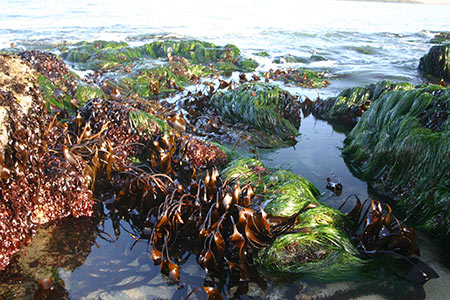
The laboratory facilities are located adjacent to Horseshoe Cove and the outer coast. An almost continuous shoreline bench of dioritic granite, most of it exposed to the pounding waves characteristic of the Sonoma coast, supports a diverse community of marine algae and invertebrates. Numerous tidepools and adjacent waters harbor a rich array of fish species, and shorebirds forage on the rocks and in extensive mussel beds during low tides.
Sandy Beach
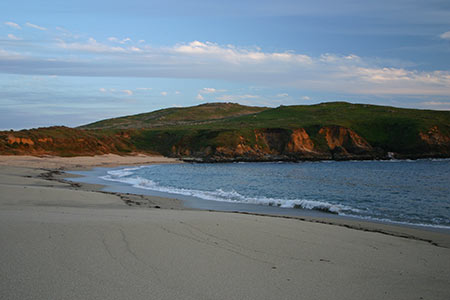
Mudflats and Sandflats
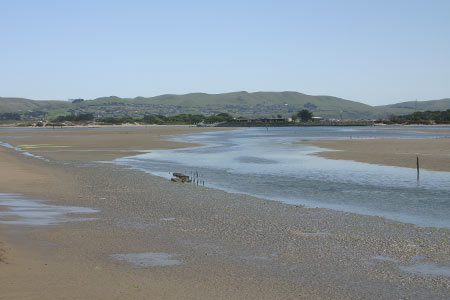
Bodega Marine Reserve leases approximately 90 acres of Bodega Harbor intertidal flats, with a third of the area closed to the public to protect research sites. Thousands of migrant shorebirds winter at Bodega Bay each year, attracted by the wide range of benthic invertebrates living in these soft sediments.
Saltmarsh
 An unusually diverse saltmarsh community occupies the high intertidal zone bordering the Reserve sandflats. Several native saltmarsh plants of limited distribution occur here. Another marsh, more brackish in nature, occurs at the lower edge of the freshwater wetlands near the BML Housing.
An unusually diverse saltmarsh community occupies the high intertidal zone bordering the Reserve sandflats. Several native saltmarsh plants of limited distribution occur here. Another marsh, more brackish in nature, occurs at the lower edge of the freshwater wetlands near the BML Housing.
Coastal Bluffs
 The blufftops of the Reserve support a mainly native plant community with many colorful wildflowers. To maintain the high native biodiversity, Reserve staff actively control invasive species such as the South African iceplant, Carpobrotus spp.
The blufftops of the Reserve support a mainly native plant community with many colorful wildflowers. To maintain the high native biodiversity, Reserve staff actively control invasive species such as the South African iceplant, Carpobrotus spp.
Coastal Prairie/Coastal Scrub
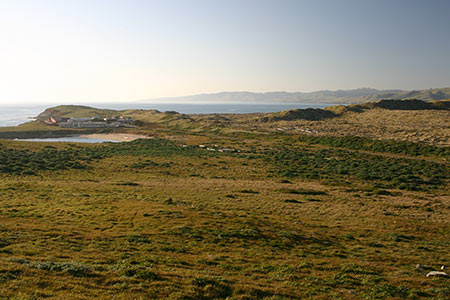
Over much of the Reserve uplands, coastal grasslands merge with areas dominated by the yellow bush lupine, Lupinus arboreus. Grasslands vary from areas with a diverse native flora to patches of weedy invasive species. These systems have been the focus of numerous studies, many continuing, of plant-insect interactions and plant community dynamics on the Reserve.
Sand Dunes
 The Reserve dunes are largely covered with yellow bush lupine and the introduced dune grass, Ammophila arenaria, planted in the 1920s-1950s to stabilize actively blowing dunes. Some areas, however, still support a mostly native dune scrub community, with Lupinus chamissonis and Ericameria ericoides as the dominant shrubs, surrounded by a rich mixture of grasses and forbs. Bodega Marine Reserve has an agreement with State Parks for researcher access to a 20-acre area of native dune adjacent to the Reserve.
The Reserve dunes are largely covered with yellow bush lupine and the introduced dune grass, Ammophila arenaria, planted in the 1920s-1950s to stabilize actively blowing dunes. Some areas, however, still support a mostly native dune scrub community, with Lupinus chamissonis and Ericameria ericoides as the dominant shrubs, surrounded by a rich mixture of grasses and forbs. Bodega Marine Reserve has an agreement with State Parks for researcher access to a 20-acre area of native dune adjacent to the Reserve.
Freshwater Wetlands
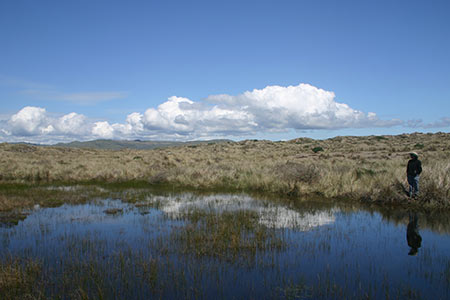
Small, seasonal or permanent, freshwater wetlands occur at many sites within the dunes on the Reserve. The photo shows a wetland that grades from fresh to brackish near BML Housing.
